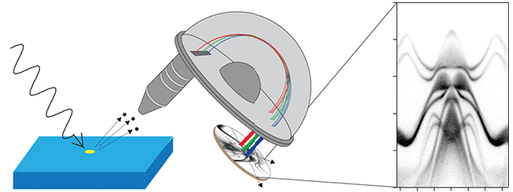
—
P.D.C. King, S. Picozzi, R. Egdell, G. Panaccione. Angle, Spin, and Depth Resolved Photoelectron Spectroscopy on Quantum Materials, Chemical Reviews (2020). DOI: 10.1021/acs.chemrev.0c00616
“The collective behavior of electrons in condensed matter is one of the central topics of modern science and technology. […] The ability to directly measure the electronic structure is an essential prerequisite to understanding, creating, and ultimately designing new quantum materials, be it in bulk form, as few-layer heterostructures, or with modified surface properties.”
This review paper explores the power of S-ARPES in the investigation of quantum materials.
Abstract
The role of X-ray based electron spectroscopies in determining chemical, electronic, and magnetic properties of solids has been well-known for several decades. A powerful approach is angle-resolved photoelectron spectroscopy, whereby the kinetic energy and angle of photoelectrons emitted from a sample surface are measured. This provides a direct measurement of the electronic band structure of crystalline solids. Moreover, it yields powerful insights into the electronic interactions at play within a material and into the control of spin, charge, and orbital degrees of freedom, central pillars of future solid state science. With strong recent focus on research of lower-dimensional materials and modified electronic behavior at surfaces and interfaces, angle-resolved photoelectron spectroscopy has become a core technique in the study of quantum materials. In this review, we provide an introduction to the technique. Through examples from several topical materials systems, including topological insulators, transition metal dichalcogenides, and transition metal oxides, we highlight the types of information which can be obtained. We show how the combination of angle, spin, time, and depth-resolved experiments are able to reveal “hidden” spectral features, connected to semiconducting, metallic and magnetic properties of solids, as well as underlining the importance of dimensional effects in quantum materials
—

Leave a Reply